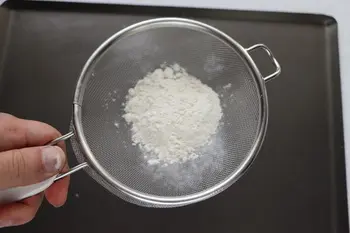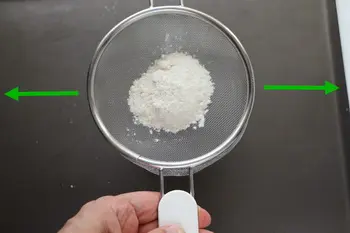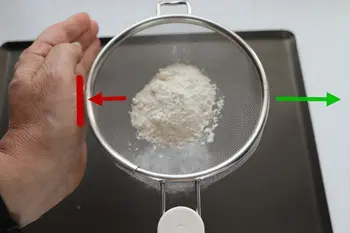This site uses only a few technical cookies necessary for its operation. By continuing to browse, you accept their use.
To find out more...
To find out more...
How to sprinkle well?

When in a recipe you need to sprinkle something, that is to say to spread a fine layer of powder (flour, sugar, etc.) on something, powdered sugar on a pie for example, you will probably use a fine strainer or a sieve, this is the best way to proceed.
But is that all?
But is that all?
10 K 4.7/5 (18 reviews)
Keywords for this post:TipsTricksStrainerPowderSprinkleSprinklingLast modified on: May 23th 2023
How to sprinkle well?
At the beginning you will realize that it is not that easy, and that it is very easy to put a little bit everywhere badly distributed vs a thin regular layer.
Especially if you go fast enough (with a spoon for example), the best way to make small piles of powder badly distributed on the targeted surface.
The use of a sieve or a sprinkler, which I have already mentioned, is almost indispensable in practice, as it contains the powder to be spread evenly and allows it to be spread "in the rain", thus sprinkling.
But, in a very natural reflex you will probably do this:
The practical trick is to block the colander with your hand when it reaches the limit of the right surface.
So you take a little momentum to the right (green arrow), and you go to the left where your hand blocks the colander (red arrow) with a tiny shock against your hand, a shock that still helps the sprinkling.
Of course, if you are left-handed, you will reverse the direction.
It is a very simple and effective gesture, try it the next time you have to sprinkle.
Especially if you go fast enough (with a spoon for example), the best way to make small piles of powder badly distributed on the targeted surface.
The use of a sieve or a sprinkler, which I have already mentioned, is almost indispensable in practice, as it contains the powder to be spread evenly and allows it to be spread "in the rain", thus sprinkling.
But, in a very natural reflex you will probably do this:

The practical trick is to block the colander with your hand when it reaches the limit of the right surface.

So you take a little momentum to the right (green arrow), and you go to the left where your hand blocks the colander (red arrow) with a tiny shock against your hand, a shock that still helps the sprinkling.
Of course, if you are left-handed, you will reverse the direction.
It is a very simple and effective gesture, try it the next time you have to sprinkle.
Lasts posts
Butter vs. grease
We often read in a recipe where a pastry is put into a mould that, just before pouring, the mould should be buttered or greased. But what's the difference between these 2 terms?December 1st 20259555
Getting out of the fridge early
Very often when you're cooking, you need to take food or preparations out of the fridge, to use them in the recipe in progress. There's nothing tricky about this: you just take them out of the fridge and use them, usually immediately, in the recipe. But is this really a good method?November 24th 20251,0865
Who's making the croissants?
When you look at a bakery from the outside, you naturally think that in the bakery, the bakers make the bread, and in the laboratory, the pastry chefs make the cakes. It's very often like that, with each of these professions having quite different ways of working, but sometimes there's also one...November 23th 2025984
Oven height
When we put a dish or cake in the oven, we naturally tend to put it on the middle shelf, and that's what we usually do. But in some cases, this position and height can be a little tricky, so let's find out why.October 8th 20252,6845
The importance of sieving
In recipes that use a fine powder (flour, powdered sugar, etc.), you'll often see the advice to sift before using it. To sift is to pass the powder in question through a sieve (a very fine strainer) before incorporating it into your recipe. It's often advice, but is it really useful?September 3rd 20257,5073
Other pages you may also like
Tranché, dissociated, failed, in short... missed!
When preparing a sauce or a cream, there's always a (small) risk that the creamy preparation you're working on will suddenly separate into two parts of different textures: a liquid part, for example, and a more or less solid part, or even become lumpy. It's terribly frustrating, but we'll see...June 19th 202313 K5
Cleaning endives
If you buy your endives elsewhere than in supermarkets, and in this case the best is of course from a market gardener, he or she is the one who planted and harvested them, in this case you will have endives full of earth or sand, depending on where they were grown, which is normal and reassuring, we...March 24th 202026 K4.6
The return of the "Norman hole"
You maybe know the "trou normand", this old gastronomic custom typically French which consists in taking a (small) glass of calvados, generally between the last course and the dessert? It's something that seems a bit anachronistic nowadays, having a glass of an alcohol of more than 60° in the...December 18th 202115 K4.8
Candied fruits: don't get ripped off
Do you like candied fruit? You might like to nibble a handful or add it to a recipe, like a classic fruit cake or delicious Italian specialities like panettone or sicilian epiphany pie.June 21th 201767 K 24.2
A few tips for effective kneading at home
When you have to knead dough for bread or some other recipe, you may well use a food processor or the type of machine known as a stand mixer. The best-known brands are Kenwood and KitchenAid. They are useful tools, but here are a few tips to help you get the best out of them.June 23th 2021284 K 23.8
Post a comment or question
Follow this page
If you are interested in this page, you can "follow" it, by entering your email address here. You will then receive a notification immediately each time the page is modified or a new comment is added. Please note that you will need to confirm this following.
Note: We'll never share your e-mail address with anyone else.
Alternatively: you can subscribe to the mailing list of cooling-ez.com , you will receive a e-mail for each new recipe published on the site.









